Site Map
Images

Sacred Darkness
Sculptural Fabrications of Story and Place
by John Watrous, January, 2001
Exhibition: Feb 1st to Mar 15, 2001
Santa Rosa Junior College Art Gallery
The First Show of the
3rd Millennium
About the Work
Story
Narrative
has never been a significant inspiration for my work prior to this
show. However, having been a gallery director made me realize how
important knowing the person (the narrative) was to understanding the
work. I often remember seeing notes, sketches and photos in artists
studios which added context to the work. For this reason I feel
compelled to relate the stories around my work. Taken as a whole they
might shed some light on the show and me. Some titles are more
geographic and some relate to my continuing interest in the invisible
parts of the electromagnetic spectrum. Several are inspired by
technical, collaborative projects with a friend who is an engineer.
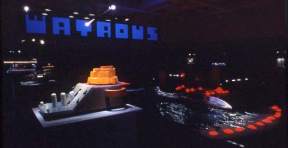
The
Rowing Scull Kinetic Installation
I've
always liked to row. Once on the American River I took over for the
guide just because I couldn't just sit when I could row. My time is
limited on real rowing sculls, but I learned how delicate they are and
learned how difficult it is to get back in after falling out.
There was something
about the rhythm, like a heartbeat that connected human to machine.
And the oars--how they do all the work including balance and how the
grips move inward together and apart. I like the whole thing--the
interface, the rhythm and being on the water.
I enjoy
the process of making a mechanical analogy for rowing. The gearmotor
and the vee belts and pulleys remind me of the motorized prayer wheels
I saw at Odiyan, the Bhuddist retreat in Sonoma county.
There is something about making mechanical
interpretations of inherently non-mechanical objects and even spritual experiences
I find both interesting and indicative of this era. I love combining
art-making with solving engineering problems which are necessary to
see the art. And I loved working with my friend and fellow
artist-engineer Michael McGinnis without whom I would have had no one
to share my mechanical frustrations.
The
installation around the scull is a collaboration with my wife,
Greer Upton. We created a theatrical sense of space and
drama for the scull to be seen on water.
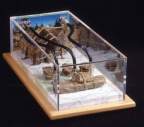
Ball
Rock
Ball Rock
lies just West of Corning about an hour from Interstate 5. It sticks
out into the Sacramento Valley so you can see farther South towards
Bakersfield than from any other point in the Yolla Bolly Wilderness
area. It's a great site for ham radio and that's why I ended up
there on a September weekend with my friend Glenn Elmore. He had
used the properties of this site to set a world record using etremely
high and little known parts of the spectrum years earlier. And it
was a nice place to look at the stars. On the way to Ball Rock we had
an event memorialized in my piece.
The
trailer we were pulling got away from us. By the time we assessed
the damage we were almost instantly saved by a stranger who pulled
up, after illegally driving across I-5 and asked if he could help.
We had lost our hitch pin and to our amazement, he had one and gave
it to us. Before he drove off I got his name: Troy, the "hitch
pin angel." The weekend was spent searching the ether doing ham
radio using frequencies little used by anyone, especially
Californians. We used 3 very high frequencies, thus the 3 section of
the piece. The shale in the piece comes from an incredible pile used
as the base of of 1930's radio tower at the site.

Wisconsin
Uncle
Albert, not an uncle at all but a good friend who treats us royally
like an great uncle, invites my wife and I to upper Wisconsin in the
late summers. The geography is so different from what I am used to.
Birch bark everywhere--the inner is tree dead and the bark lives on.
Thousands of lakes each bordered with forests and another lake
beyond, completely introspective and without any visibile, high
altitude landmarks. I get lost without landmarks but always know
there is a lake just beyond. Albert loves the area and takes us on
hikes so we won't go home without sensing his special relationship of
the place. With so much water everywhere, I spend time canoeing and
attempting to row his single scull. Butternut Lake completely
freezes over in the winter so that the life around it when I visit
seems even more fragile and transient.
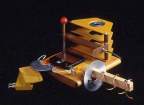
Helix
Dr. John
Kraus is a retired electrical engineering professor from Ohio State,
he also wrote 'the' book on antennas. Kraus also wrote a book about his
life called The Big Ear, for
one of his loves was listening for intelligent life in the cosmos
with 'big ear' radio astronomy antennas. His childhood had parallels
to my own. But the story he told about inventing the helical antenna
(the kind now used on satellites) became the most important for me.
When he was a young teacher he asked his senior colleagues if they
thought the helix might be used as an antenna. They quickly told him
that they had tried and it didn't work. Unconvinced, but not wanting
to upset them, he started working on the idea at home. When he had
made it work and got it patented he said that if his seniors hadn't
been so sure it wouldn't work, he might not have even tried. After
making some helical antennas for a project I built this homage to
John Kraus and as a reminder to me about the grist often needed for
creative research. I wrote Dr. Kraus and got his permission to use
his story as an creative illustration for my students.
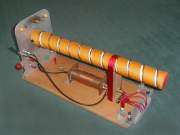
Gearhart
Al
Gearhart is a Sonoma county rancher, working a few head of cattle
right in my backyard so to speak just 4 miles from where I live. If
you look due West from the Santa Rosa Plain you will see the
square-topped trees, a small group of redwoods just West of Al's
ranch. Al kindly let me and use a hill on his property for an
experimental radio site related to a project combining the
internet with radio.
The site is unique since from it you can see both
downtown Santa Rosa and deep into the Atascadero valley where I live.
I used it to listen to the cows on his hill from home, send
data at high
speeds and generally play in the 'ether,' the invisible part of the
electromagnetic spectrum. Many treks carrying radio equipment up to
'Gearhart Ridge' have given me good memories about the place, the
changes seasons bring, from young alfalfa grass to hay bales and how
tramping around the high places in Sonoma county gives me a
better sense of place.
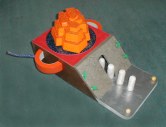
Monte
Alban
High above
the Oaxaca plateau sits this ancient Mixtec/Zapotec site. I like the
slow drive up the switchbacks to the hill, separating it from the
town below. I've been there twice and each time I am drawn to the
Observatorio, a large structure at one end of the grand open area
facing Southwest. Locals can't say why the Observatorio faced the
Southwest or what stars the ancients were drawn to and that mystery
is another part of the fascination for me. I stood beside it and
took a Global Positioning Satellite waypoint so if you need to
know exactly where the Observatorio is: (it's 17.04241 degrees North,
96.76811 degrees West). Attempts by
earlier people to understand this Planet and our place in the larger
Cosmos intrigue me. Farther South, the columns of Mitla, another of
the many archeological sites in this area, influenced me even with
the tourist stuff almost hiding the site. Mitla is the farthest South
into the
state of Oaxaca I've been. The last time I visited Monte Alban I
overheard a Mixtec guide speak his language. What a kick to hear
Mixtec spoken here which sounds like birds chirping.
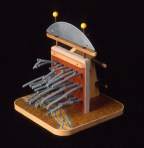
Lithia
I've visited Lithia Park often (once as solace from work
stress) and enjoy how it grows organically up the creek starting
right at the Ashland, Oregon, Shakespeare Festival buildings. It was
designed by John McLaren who also designed
Golden Gate Park in San Francisco. It's mostly organic, but
that Sycamore Grove! It's rigid grid of 8 trees across by 8 trees
going up the hill--it's laid out like a Christmas tree farm in the middle of
such a beautiful park. It draws me to it and I wonder why it's there
and curiously I like viewing the park from within its rigid matrix altering
visual alignments of the park. I've talked to people who work in the
park and they say the Sycamores are dirty and die young. They too
wonder about the grid and are replanting now with another variety,
but keeping the grid. I wonder why such a mechanical form exists in
this park and next to the Japanese garden to boot.

Checkerboard
Prayer Wheel
I took the
Odiyan tour, a Bhuddist retreat an hour North of my home. It was almost
20 years after they began construction,
but what an unusual place here in Sonoma county. About 1200 prayer
wheels, motorized with back up generators, running on pulleys and vee
belts, some the size of 55 gallon drums (those with a mile of paper
prayers rolled up inside). I likened the sound of the wheels purring and
moving their prayers into the ether to radio--invisible energy on
those wonderful bluffs overlooking the Pacific. I am attracted to the
physical action in the act of prayer and the process of designing a
prayer to be rolled up and hidden. I found websites where Buddhists
geeks developed ways to use hard drives as prayer wheels.
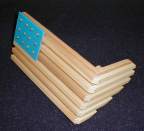
Wood
Flag
The
American or rather United States of America flag can be seen as a
simple handful of design elements: 2 rectangles some stripes and
stars. I became aware of this while assigning a flag project in a class.
A few rearrangeable elements encourages interpretation. I have
enjoyed the tight limits and abstracting the flag from a 2 to 3
dimensions.
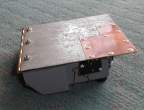
Heart
Beat
Opens to a
LED heart rhythm...interactive..just a little piece with a surprise.
I am drawn to electronics but without having to be plugged into the
wall.

Copper
Collages
From a
series of galvanized and copper collages using industrial materials.
I became good at collage while in college and grew to distrust
facility. I gave up on collage several times but keep coming back to
it. For a time I replaced gluing for taping and in this series I use
pop rivets and hardware. Starting with a format or size limit
encourages me to develop permutations of an idea.
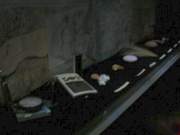
Pebbles
On April
10th, 1998 on a beach near Olympos, Turkey, I collected pebbles which
had once been the marble from the ancient town of Olympos, at the
foot of the Silk Road. Since then I have collected pebbles at
various sites as a way to remember places.
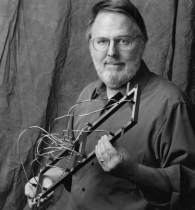
Light
The amount
of light is purposely low in the gallery to create a sacred space and to
discourage casual viewing by keeping the viewer in the space longer.
Hopefully the time required for eyes to adjust to the low light level,
called dark adaptation time
(see below), will reveal more and more
information in the work over time. I am eliminating as much
ambient light as possible and am only subtly marking the limits
of the space.
I am using a new kind of lighting, possibly never before used for
galleries. Light emitting diodes or
LED's have become available fairly recently for projected, white lighting.
The 20 fixtures and almost 200 bright, white LED's are prototypes for
future gallery lighting and will hopefully be used in the future for
all kinds of architectural applications. The total energy used by
lighting in this
show is far less than one, standard gallery lamp. Thanks to a friend
for his skematic and briefing
I now understand LED's better. I used Sloan
SL905WC-13 bright white LED's powered by 5VDC switching power
supplies through 90 Ohm series resistor networks which maintains
about 16 mA through each diode. Estimated life for the LED's is over
eleven years! The LED's emit 3700 millicandelas making the fixtures
I designed using ten LED's put out about 37 candelas, a standard
measurement for light output.
White LEDs
generally appear at coordinates 310x by 320y on the standard CIE
chromaticity chart, and have a color rendering index of 85 or
greater. Color temperature can range from 5,500°K to as high as
8,000°K, with a few odd samples going even higher. Generally, a
good white LED will have a color temperature of 6,500°K, which is
approximately the same as noonday sun at the Earth's equator.
References:
http://www.misty.com/~don/ledx.html...Overall information
http://ledmuseum.home.att.net...Testing, diagrams
Dark Adaptation Time
After the
first 15 minutes in total darkness you might think you're night
vision is fully developed, but no. Tests show that your eyes gain
about another two magnitudes of sensitivity -- in other words, a
factor of six in how faint you can see -- during the next 15 minutes.
Thereafter, dark adaptation improves very slightly for 90 minutes
more.
In
practice, complete darkness is unattainable. Light pollution aside,
you need some light to see what you're doing. Astronomers have long
used a dim red flashlight because red light has less effect on night
vision. The reason is that in near-darkness you see with the "rod"
cells in your retina, and these are blind to the far red end of the
spectrum. When you see red light your "cone" cells are at
work; these are the receptors responsible for normal daytime color
vision. (You have three types of cones -- red, green, and blue -- but
only one type of rod, which is insensitive to red.) The idea is to
use the red cones for reading charts and swapping eyepieces, while
protecting the rods for the most delicate work at the telescope
eyepiece.
References:
http://web.utk.edu/~wverplan/biblio10.html...medical
factors: rods (light)and cones (color)
http://homepages.paradise.net.nz/~zog/ds/socks/starting.html
...astronomy relationships
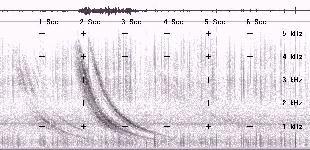
Sound
The sounds heard in the gallery are generated by lightning, propagated
through the Magnetoshpere and recorded with a special radio receiver.
The radio is tuned to a very low frequency or VLF which is actually
within the upper audio range, but not available to human audio hearing.
These sounds are called natural radio sounds as they occur naturally,
it is just that we can't hear them without technological assistance.
I have a VLF receiver and have recorded some sounds, but most you hear
have been recorded by the real expert, my friend Stephen McGreey, who
now has CD's available. Steven has travelled the world recording VLF
sounds and is listed on scientific websites as a contributor. He has
written extensively on the subject and all his information can be found
on his
Natural Radio
website.
Updated: 22 Jan 2003
john@jwatrous.org 














